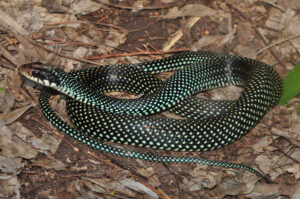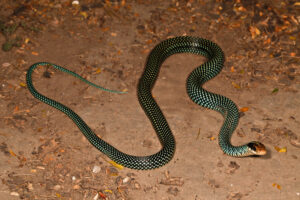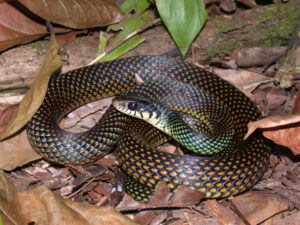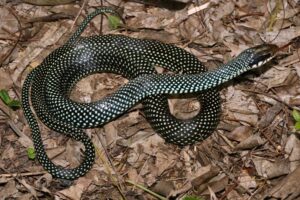The speckled racer is a predominantly diurnal colubrid native to the Americas. The specific name margaritiferus, which means ‘pearl-bearing’ in Latin, refers to the pearl-like spots on the dorsal scales of the snake. As the ‘racer’ in its name implies, it is a fast and agile snake.
Scientific Classifications
- Suborder:Serpentes
- Family:Colubridae
- Genus:Drymobius
- Species:D. margaritiferus
Conservation Status
Subspecies
This snake has four recognized subspecies.
- Northern speckled racer (Drymobius margaritiferus margaritiferus)
- Central American speckled racer (Drymobius margaritiferus fistulosus)
- Western speckled racer (Drymobius margaritiferus occidentalis)
- Drymobius margaritiferus maydis
Description
Size
The average length is 30-40 in (76-102 cm), with the record being 50 in (127 cm).
Color and Appearance
The racer’s color is typically black with distinct yellow and blue spotting – one light-colored spot on each scale, giving the colubrid an overall greenish shade. The yellow labials have black sutures. The ventral side is typically yellow to green.
The dorsal scales are feebly keeled mid-dorsally but smooth at the periphery. They are arranged in 17 rows. There are 142-168 ventrals and 85-126 subcaudals.
Are They Dangerous to Humans
The nervous species doesn’t hesitate to bite in self-defense when handled or restrained. But it is non-venomous. Death feigning is also a defense tactic exhibited by around 30% of the species.
Speckled Racers at a Glance
Distribution
It can be found throughout Central America from the Yucatán Peninsula and Isthmus of Tehuantepec northward to the lower exterior slopes of the Sierra Madres of Mexico and the coastal lowlands, up the east coast to northern Tamaulipas and the west coast to Sonora. The northern limit of its range extends into extreme south Texas, USA, where the species becomes uncommon to rare in a few of the southernmost counties. Southward the snake ranges to Panama and neighboring areas of northwest Colombia, at elevations from sea level to 4,750 feet (1,453 m).
Habitat
The snake lives in a wide range of habitats, including forests, forest clearings and edges, riparian zones, secondary growth, marshlands, pastures, savannahs, and roadsides. The speckled racer prefers wet and humid areas with permanent water sources. But it has been found in areas with no sources of water, and its habitat includes tropical arid and dry forests.
Lifespan
It lives for around 5 years in the wild and 10 years in captivity.
Predators
The speckled racer has numerous predators, including birds of prey, coyotes, foxes, and other giant snakes.
Diet
A wide variety of prey, including lizards, small mammals, and reptile eggs, form its diet but it mainly eats toads and frogs.
Reproduction
Oviparous (lays eggs that hatch outside the body)
The speckled racer typically lays eggs in spring. However, eggs are deposited in southern areas as early as February and March. 2-8 eggs of 1.5 in (3.8 cm) length form a clutch. The incubation period is typically 8-9 weeks, with the hatchlings measuring 6-10.5 in (15.2-27.6 cm).
Source
thehibbitts.net, cages.smugmug.com, srelherp.uga.edu, flickr.com









